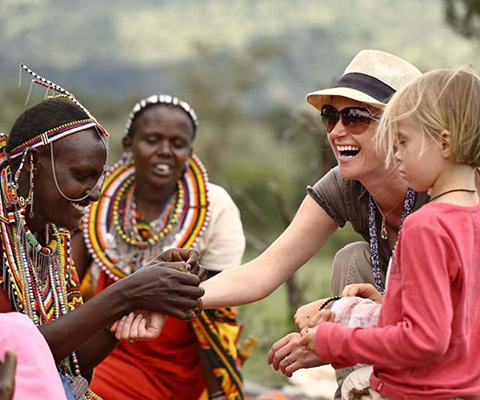By Sultan Kennedy
Tucked away in the western highlands of Kenya lies Kakamega Forest. Kakamega Forest is the last tropical rainforest in Kenya, and it’s bursting with life. This ancient forest isn’t just a beautiful escape—it is a haven for birds, with some of Africa’s rarest and most colorful species. If you’re into birdwatching or just love nature, Kakamega is a must-visit. It’s like stepping into a world where every tree has a story and every bird adds a splash of magic.
A Biodiversity Hotspot Worth Exploring
What makes Kakamega Forest stand out among forest tours in Kenya? The numbers speak volumes. According to BirdLife International, this forest holds:
- Over 410 recorded bird species, including many that are not found anywhere else in Kenya.
- 194 forest-dependent species, making it the forest with the highest number of such species in the entire country.
- At least 16 bird species occur nowhere else in Kenya, and 30 more are likely confined solely to Kakamega.
- Relict populations of globally threatened birds like the Turner’s Eremomela and Chapin’s Flycatcher.
This extraordinary diversity has made Kakamega Forest one of the most important bird habitats in East Africa. Serving as a “living museum” of tropical biodiversity.
Meet Kakamega’s Most Striking Native Birds
Whether you’re a seasoned birder or a curious traveler, these four birds will steal your heart and your camera lens. Here’s a closer look:
1. Great Blue Turaco (Corythaeola cristata)
Why it dazzles: This large, majestic bird sports deep blue plumage with green highlights and a bright yellow bill. It is often dubbed the forest’s mascot. Its slow, deliberate movements through the canopy are mesmerizing.
Where to spot it: Often seen gliding through the upper canopy in pairs or small groups.
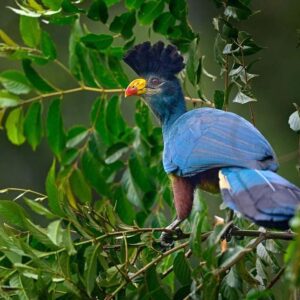
Spot the vibrant Great Blue Turaco in Kakamega Forest, a gem for birdwatchers, Photo by © Ondrej Prosicky
2. Blue-headed Bee-eater (Merops muelleri)
Why it dazzles: With its mix of turquoise and emerald feathers, this beauty adds a splash of color to the forest. Often spotted with insect prey in its beak, it’s a photographer’s delight.
Where to spot it: Perched on open branches near clearings or forest edges.
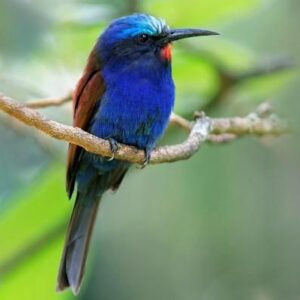
The Blue-headed Bee-eater in Kakamega Forest is a top sight for forest tours Kenya. Photo by © Yann Kolbeinsson
3. Black-and-white-casqued Hornbill (Bycanistes subcylindricus)
Why it dazzles: With its massive casque-topped bill and echoing calls, this bird dominates the treetops like a sentinel of the forest.
Where to spot it: In tall trees, feeding on fruits and occasionally small animals.
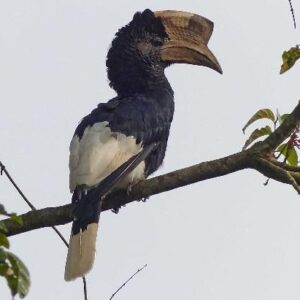
The Black-and-white-casqued Hornbill in Kakamega Forest is a top sight for forest tours Kenya. Photo by © Peter Kaestner
4. African Emerald Cuckoo (Chrysococcyx cupreus)
Why it dazzles: Shimmering in metallic green with a golden belly, this elusive cuckoo sings a four-note whistle that birders often mimic as “Hello Judy.”
Where to spot it: Quietly foraging deep in the undergrowth or mid-canopy.
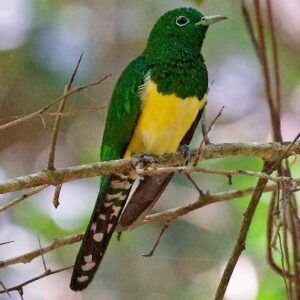
The African Emerald Cuckoo in Kakamega Forest is a top sight for forest tours Kenya. Photo by © Matt Brady
More Feathered Gems of Kakamega
Kakamega Forest is also home to rare and lesser-known species. These will excite even the most experienced birders:
- Turner’s Eremomela – Globally threatened, found only here and parts of DR Congo.
- Chapin’s Flycatcher – A regional rarity tied to older forest growth.
- Red-headed Malimbe – Crimson splendor weaving intricate nests.
- Yellow-spotted Barbet – A true forest specialist, often identified by its melodious call.
Other sightings may include:
- White-headed Wood-hoopoe (quirky and social)
- Buff-throated Apalis, Dusky Tit, Uganda Woodland-Warbler, and more.
Check the updated checklist from birders globally via eBird, Kakamega Forest Hotspot →
Best Time to Visit Kakamega Forest for Birdwatching
The forest is accessible all year round. But for serious birding Kenya adventures, November to April is the ideal time to visit. This period sees migratory birds join the resident species. You will find that breeding activity makes bird behavior more visible and vocal.
Dry seasons (January–March and July–October). This period offers easier hiking and fewer mosquitoes—great for comfortable forest treks.
Tips for the Best Birding Experience
For a memorable trip, preparation is key. Below are some tips to get you started on the right footing.
1. Go With a Local Guide
Birding in Kakamega is as much about hearing as seeing. A knowledgeable local guide can help you identify birds by call, find hidden species, and interpret behavior. For guides, visit the Kakamega Environmental Education Programme (KEEP) or the local community conservancies. Your fees often support forest conservation directly.
2. Bring Your Gear
- Binoculars (8×42 recommended)
- Bird field guide for East Africa (or download Merlin ID/Ebird)
- Camera with zoom lens for those high-canopy dwellers
- Notebook or mobile app for checklist.
3. Stay Nearby
Find accommodations like Rondo Retreat, Isecheno Forest Station, or Udo’s Bandas nearby. They offer immersive forest stays with early-morning birding opportunities right at your doorstep.
Why Kakamega is a Must-Visit for Nature Lovers
Kakamega isn’t just a birding paradise—it’s a full forest adventure. Along the trails, you’ll spot rare butterflies, reptiles, and forest monkeys like the endangered De Brazza’s monkey. The forest is also home to indigenous medicinal plants that local communities have used for generations. Every corner offers something new. It’s a chance to explore, discover, and reconnect with nature in one of Africa’s most untouched tropical forests.
Plan Your Forest Tour Today
A forest full of wonders, Kakamega Forest blends peaceful nature with exciting birdwatching. Walk among ancient trees as rare birds call and fly overhead. You might hear the eerie whistle of the African Emerald Cuckoo or spot the stunning Great Blue Turaco. It’s a place where every sound and color draws you deeper into Kenya’s wild beauty.
Ready to see Kakamega Forest birds in their natural splendor? Get ready for an adventure—Kakamega is one of Africa’s best places to see amazing birds. To prepare for a splendid time, consider working with us at Travel Mora. We offer the best accommodation reviews and smart booking tips. You can get a tailor-made travel plan to ensure you get the most out of your trip. Visit us at travelmoran.com, and let us realize your journey together.
For more details on birdwatching, visit:
🔗 BIOTA Africa – East Africa Bird Stats
🔗 Kakamega Birding on SafariBookings


